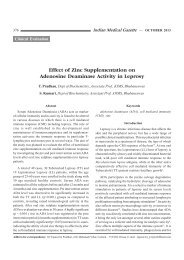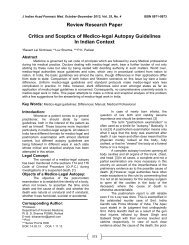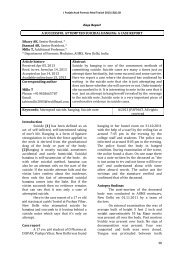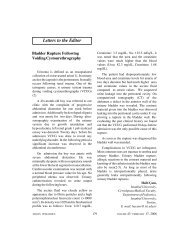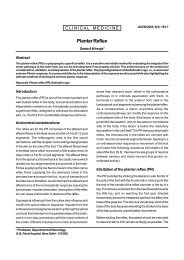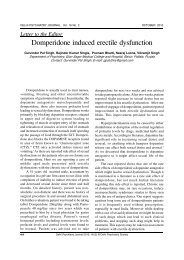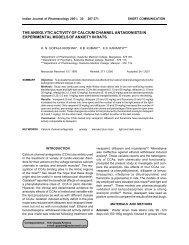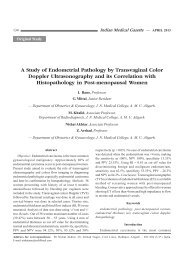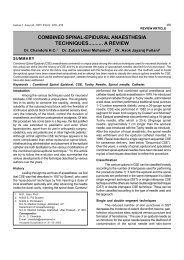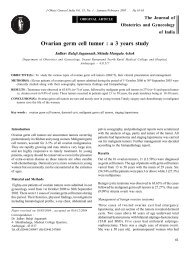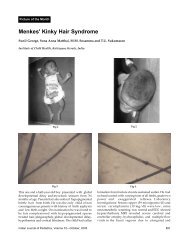alkaptonuric ochronosis : report of a case and brief review - medIND
alkaptonuric ochronosis : report of a case and brief review - medIND
alkaptonuric ochronosis : report of a case and brief review - medIND
Create successful ePaper yourself
Turn your PDF publications into a flip-book with our unique Google optimized e-Paper software.
Indian Journal <strong>of</strong> Clinical Biochemistry, 2007 / 22 (2)<br />
Indian Journal <strong>of</strong> Clinical Biochemistry, 2007 / 22 (2) 158-161<br />
CASE REPORT<br />
ALKAPTONURIC OCHRONOSIS : REPORT OF A CASE AND BRIEF REVIEW<br />
K. Pratibha, T. Seenappa* <strong>and</strong> K. Ranganath**<br />
Department <strong>of</strong> Biochemistry, SS Institute <strong>of</strong> Medical Sciences & Research, Davangere<br />
* Department <strong>of</strong> Orthopaedics, J.J.M. Medical College, Davangere<br />
**Department <strong>of</strong> Oral <strong>and</strong> Maxill<strong>of</strong>acial Surgery, M.S. Ramaiah Dental College & Hospital, Bangalore<br />
ABSTRACT<br />
Alkaptonuria, a metabolic disorder characterized by a triad <strong>of</strong> homogentisic aciduria, arthritis <strong>and</strong> <strong>ochronosis</strong><br />
is one <strong>of</strong> the first conditions in the charter <strong>of</strong> group <strong>of</strong> inborn errors <strong>of</strong> metabolism proposed to have Mendelian<br />
recessive inheritance. It is due to the deficiency <strong>of</strong> the enzyme homogentisic acid oxidase which catalyzes the<br />
conversion <strong>of</strong> homogentisic acid to maleylacetoacetic acid in the catabolism <strong>of</strong> tyrosine. Homogentisic acid<br />
thus accumulates in cells <strong>and</strong> body fluids <strong>and</strong> its oxidized polymers bind to collagen, leading to progressive<br />
deposition <strong>of</strong> grey to bluish black pigment resulting in degenerative changes in cartilage, intervertebral disc<br />
<strong>and</strong> other connective tissues, leading to arthritis which is the only disabling effect in an affected older individual.<br />
However the diagnosis can be made in neonates when blackish stain is noticed in an unwashed diaper.<br />
Alkaptonuria is treated symptomatically, surgical intervention necessitates in advanced stages, treatment<br />
with ascorbic acid (Vitamin C) <strong>and</strong> dietary restrictions <strong>of</strong> food containing phenylalanine <strong>and</strong> tyrosine have<br />
proved to be successful in alleviating the symptoms.<br />
KEY WORDS<br />
Ochronosis, Alkaptonuria, Ochronotic arthritis<br />
INTRODUCTION<br />
Ochronosis in other terms called as Alkaptonuria (AKU) arises<br />
from the Arabic word alkapton for “alkali” <strong>and</strong> Greek word “to<br />
suck up oxygen greedily in alkali” based on the observation<br />
that the urine becomes black on st<strong>and</strong>ing when it becomes<br />
alkaline. This disorder is <strong>of</strong> considerable historical interest in<br />
that it was one <strong>of</strong> the original “inborn errors <strong>of</strong> metabolism”<br />
described. At the turn <strong>of</strong> the 20 th century, Archibald Garod, a<br />
pediatrician, recognized that the syndrome, which has been<br />
called AKU, showed a pattern <strong>of</strong> familial inheritance. It was<br />
proposed that AKU <strong>and</strong> certain other disorders were due to<br />
genetic defects, each <strong>of</strong> which resulted in the lack <strong>of</strong> activity<br />
<strong>of</strong> a particular metabolic enzyme. Forty five years later, it was<br />
confirmed that the biochemical defect in AKU is a lack <strong>of</strong><br />
Address for Correspondence :<br />
Dr. K. Pratibha<br />
Department <strong>of</strong> Biochemistry,<br />
Sree Siddhartha Medical College,<br />
Tunkur - 572 107, Karnataka<br />
homogentisate oxidase in the tyrosine catabolic pathway. This<br />
disorder occurs in about 1 in 2,50,000 births. Due to its rarity<br />
in the prevalence rate, we <strong>report</strong> this <strong>case</strong> <strong>of</strong> AKU who was<br />
diagnosed <strong>and</strong> treated at J.J.M. Medical College <strong>and</strong> Hospital,<br />
Davangere <strong>and</strong> we discuss the clinical aspect, laboratory<br />
investigations <strong>and</strong> management <strong>of</strong> this condition along with a<br />
<strong>brief</strong> <strong>review</strong> <strong>of</strong> relevant literature.<br />
CASE REPORT<br />
A 45 year old female admitted with a history <strong>of</strong> back pain,<br />
stiffness <strong>of</strong> the back, generalized weakness for the last one<br />
<strong>and</strong> half month.<br />
The backache was insidious in onset <strong>and</strong> progressive in nature<br />
associated with early morning stiffness, she was not able to<br />
get up from the sitting position without the support, she had<br />
occasional tingling sensation <strong>of</strong> the limbs. She also complained<br />
<strong>of</strong> pain in both knee joints. She had no other constitutional<br />
symptoms. She had undergone tubectomy 15 years back <strong>and</strong><br />
hysterectomy 5 years back.<br />
158
Alkaptonuric Ochronosis : A Case Report<br />
restricted movements. There were no neurological deficits.<br />
Roentgenographic findings : a routine dorsolumbar spine<br />
X-Ray revealed calcification <strong>of</strong> the intervertebral disc-spaces<br />
looking like a bamboo spine deformity <strong>and</strong> osteoarthrosis <strong>of</strong><br />
knee <strong>and</strong> hip joints (Fig. 2).<br />
Fig. 2 : X-rays showing calcification <strong>of</strong> intervertebral disc-spaces<br />
having bamboo spine deformity. Osteoarthrosis <strong>of</strong> knee<br />
<strong>and</strong> hip joints.<br />
Fig. 1A & 1B: Pictures showing pigmentation <strong>of</strong> the ear cartilage,<br />
concha <strong>and</strong> anthelix.<br />
Fig. 1C: Pigmentation <strong>of</strong> conjunctiva in the interpalpabral fissure<br />
Fig. 1D: Pigmentation <strong>of</strong> gums <strong>and</strong> teeth<br />
General examination <strong>of</strong> the patient revealed pigmentation<br />
<strong>of</strong> the ear cartilage, concha <strong>and</strong> anthelix (Fig. 1A & 1B),<br />
pigmentation <strong>of</strong> the conjunctiva on both eyes in the<br />
interpalpabral fissures (Fig. 1C), brown colour pigmentation<br />
<strong>of</strong> the gums <strong>and</strong> teeth (Fig 1D).She had impaired hearing <strong>of</strong><br />
both the ears.<br />
Local examination <strong>of</strong> the spines revealed dorsal kyphotic<br />
deformity, paraspinal muscle spasm <strong>and</strong> there was tenderness<br />
over the lower thoracic <strong>and</strong> lumbar vertebrae followed by<br />
Laboratory investigations: were as follows :<br />
Hb – 10.2 g%, TC – 7,400, DC – P – 61%, L – 32%, ESR – 17<br />
mm/hr, RBS – 90 mg%, Blood Urea – 15mg%, Serum<br />
Creatinine – 0.9 mg%, ECG – Normal<br />
Though routine laboratory investigations were normal, taking<br />
into consideration general examination, local examination <strong>and</strong><br />
radiological findings AKU was suspected <strong>and</strong> to confirm the<br />
diagnosis, following biochemical tests were performed.<br />
1. Urine turned black on exposure to air for many hours.<br />
2. Ferric chloride test: transient green color formed.<br />
3. Ammoniacal silver nitrate test: black precipitate <strong>of</strong> silver<br />
formed.<br />
159
Indian Journal <strong>of</strong> Clinical Biochemistry, 2007 / 22 (2)<br />
4. Benedicts test: gave dark supernatant, initial greenish<br />
brown precipitate followed by a yellow precipitate <strong>of</strong><br />
cuprous oxide on st<strong>and</strong>ing.<br />
5. N-butanol test: pinkish brown color developed.<br />
Based on clinical <strong>and</strong> radiological evaluation <strong>and</strong> biochemical<br />
investigations AKU was diagnosed.<br />
Treatment: Patient was treated symptomatically with<br />
analgesics <strong>and</strong> physiotherapy <strong>and</strong> was given Vitamin C 500mg<br />
daily, patient was advised to take Vitamin C rich diets. Currently<br />
the patient is asymptomatic <strong>and</strong> is under follow up every six<br />
months in the out patient clinic <strong>of</strong> the hospital.<br />
REVIEW OF LITERATURE<br />
AKU, a metabolic disorder characterized by a triad <strong>of</strong><br />
homogentisic aciduria, arthritis <strong>and</strong> <strong>ochronosis</strong> enjoys the<br />
historic distinction <strong>of</strong> being one <strong>of</strong> the first conditions in which<br />
Mendelian recessive inheritance was proposed <strong>and</strong> is also<br />
one <strong>of</strong> the conditions in the charter <strong>of</strong> group <strong>of</strong> inborn errors<br />
<strong>of</strong> metabolism (1). AKU or the excretion <strong>of</strong> urine which darkens<br />
on exposure to air, is an autosomal recessive disorder due to<br />
deficiency <strong>of</strong> homogentisic acid oxidase, which catalyzes the<br />
conversion <strong>of</strong> homogentisic acid to maleylaceto acetic acid.<br />
(2). Homogentisic acid accumulates in cells <strong>and</strong> body fluids.<br />
Its oxidized polymers bind to collagen, leading to the<br />
progressive deposition <strong>of</strong> grey to bluish black pigment (3).<br />
Cartilage apparently has a special affinity for homogentisic<br />
pigment <strong>and</strong> when sufficient amounts are aggregated within<br />
the articular plates, there is death <strong>of</strong> the chondrocytes <strong>and</strong><br />
calcification <strong>of</strong> cartilage (4,5). Alkaptonuric patients are usually,<br />
asymptomatic as children or young adults, when the affected<br />
individuals get older, pigmentation <strong>of</strong> the sclera or the cartilage<br />
<strong>of</strong> the ear start to appear (6). Pigmentation may be seen in<br />
the teeth (7), buccal mucosa <strong>and</strong> in the nails or the skin, giving<br />
these areas a dusty coloration. Arthritis is the only disabling<br />
effect <strong>of</strong> this condition, <strong>and</strong> occurs in almost all patients with<br />
advancing age (8, 9). The screening tests like fehlings or<br />
Benedicts could be confirmed by measurement <strong>of</strong><br />
homogentisic acid <strong>and</strong> its derivative benzoquinone acetic acid<br />
by enzymatic spectrophotometry (10) or by using gas liquid<br />
chromatography (11) or by high pressure liquid<br />
chromatography (12).<br />
Genetically, AKU is inherited as an autosomal recessive trait<br />
(13). Janocha et al (14) demonstrated linkage to microsatellite<br />
markers from proximal 3q. Markers on that chromosome were<br />
selected for study because <strong>of</strong> previously demonstrated<br />
homology <strong>of</strong> synteny with mouse chromosome 16 (15).<br />
Independently, Pollak et al (16) used homozygosity mapping<br />
to locate the <strong>alkaptonuric</strong> gene to 3q 2 in a 16 CM region.<br />
Sucrase-isomaltase deficiency (17) <strong>and</strong> neonatal<br />
hyperparathyroidism (18) could be co-inherited with AKU. In<br />
1996, Fern<strong>and</strong>ez-Canon et al, cloned the gene for<br />
homogentisate 1,2-dioxygenase (HGD, EC 1.13.11.5), <strong>and</strong><br />
they demonstrated that HGD harbors mutation that cosegregates<br />
with the disease <strong>and</strong> provided biochemical<br />
evidence that at least one <strong>of</strong> these missense mutations is a<br />
loss <strong>of</strong> function mutation (19).<br />
Homogentisic acid inhibits the growth <strong>of</strong> cultured human<br />
articular chondrocytes, <strong>and</strong> binds to connective tissue in rats<br />
(20). Ascorbic acid prevents these effects. Wolff et al treated<br />
two adult patients with high doses <strong>of</strong> ascorbic acid. The level<br />
<strong>of</strong> excretion <strong>of</strong> homogentisic acid did not change, whereas its<br />
derivative, benzoquinone acetic acid, completely disappeared<br />
from the urine (13).<br />
AKU a metabolic disorder, though not life threatening, disability<br />
<strong>and</strong> pain forms the major complaint <strong>of</strong> these patients. General<br />
examination, local examination <strong>and</strong> radiological examination<br />
followed by biochemical tests help in confirming the diagnosis.<br />
Osteoarthritis can be treated symptomatically as for other<br />
osteoarthritis. Surgical intervention necessitates in advanced<br />
stages. Treatment with ascorbic acid (Vit. C) <strong>and</strong> dietary<br />
restrictions <strong>of</strong> food containing phenylalanine <strong>and</strong> tyrosine have<br />
proved to be successful in alleviating the symptoms.<br />
REFERENCES<br />
1. Garrod AE. The incidence <strong>of</strong> alkaptonuria: a study in<br />
chemical individuality. Lancet 1902; 11:1616-20.<br />
2. La Du BN. Alkaptonuria. In: stanbury JB, Wyngaarden JB,<br />
Fredericson DS, editors. The metabolic basis <strong>of</strong> inherited<br />
disease. 4 th edition. New York: McGraw-Hill 1978; 268-82.<br />
3. Jaffe HL. Gaucher’s disease <strong>and</strong> certain other inflammatory<br />
metabolic disorders. Chapter 18 in metabolic, Degenerative<br />
<strong>and</strong> inflammatory diseases <strong>of</strong> bones <strong>and</strong> joints. Philadelphia,<br />
Lea <strong>and</strong> Febiger, 1972; 552-60.<br />
4. Aegerter E, Kirpatrick JA. Arthritis. Chapter 21 in Orthopaedic<br />
diseases: Physiology Pathology, Radiology, 4 th edition,<br />
Philadelphia, W.B. Saunders, 1975; 632-34.<br />
5. Di-Franco M, Caori G, Bonucci E. A morphological study <strong>of</strong><br />
bone <strong>and</strong> articular cartilage in <strong>ochronosis</strong>. Virchows Arch<br />
2000; 436 (1): 74-81.<br />
6. Osler W. Ochronosis: the pigmentation <strong>of</strong> cartilages,<br />
sclerotics <strong>and</strong> skin in alkaptonuria. Lancet 1904; 1: 10.<br />
160
Alkaptonuric Ochronosis : A Case Report<br />
7. Sickest RG, Gibilisco JA. Discoloration <strong>of</strong> the teeth in<br />
Alkaptonuria (Ochronosis) <strong>and</strong> Parkinsonism. Oral Surg Oral<br />
Med Oral Pathol 1970; 29: 197-9.<br />
8. Yules JH. Ochronotic arthritis: <strong>report</strong> <strong>of</strong> a <strong>case</strong>. Bull N Engl<br />
Med Center 1957; 16: 168.<br />
9. O’Brien WM, Banfield WG, Sokol<strong>of</strong>f L. Studies on the<br />
pathogenesis <strong>of</strong> ochronotic arthropathy. Arthritis Rheum<br />
1961; 4: 137.<br />
10. Seegmiller JE, Zannoni VG, Laster L, La Du BN. An<br />
enzymatic spectro photometric method for the determination<br />
<strong>of</strong> homogentisic in plasma <strong>and</strong> urine. J Biol Chem 1961;<br />
236: 774.<br />
11. Hill A, Hoag GN, Zaleski WA. The investigation <strong>of</strong> aromatic<br />
acids in phenylketonuria, alkaptonuria <strong>and</strong> tyrosinosis using<br />
gas-liquid chromatography. Clin Chim Acta 1972; 37: 455-<br />
62.<br />
12. Wolff JA, Barshop B, Nyhan WL. Effects <strong>of</strong> ascorbic acid in<br />
alkaptonuria: alterations in benzoquinone acetic acid <strong>and</strong><br />
an ontogenic effect in infancy. Pediatr Res 1989; 26: 140-4.<br />
13. Hogben L, Worrall RI, Zieve. The genetic basis <strong>of</strong><br />
alkaptonuria. Proc R Soc Edinb (Biol) 1932; 52: 264.<br />
14. Janocha S, Wolz W, Srsen S, Srsnova K, Montagutelli X,<br />
Guenet JL. The human gene for alkaptonuria maps to<br />
chromosome 3q. Genomics 1994; 19: 5-8.<br />
15. Montagutelli X, Lalouette A, Coude M, Kamoun P, Forest M,<br />
Guenet JL. AKU, a mutation <strong>of</strong> the mouse homologous to<br />
human alkaptonuria, maps to chromosome 16. Genomics<br />
1994; 19: 9-11.<br />
16. Pollak MR, Chou Y-H, Cerda JJ. Homozygosity mapping <strong>of</strong><br />
the gene for alkaptonuria to chromosome 3q2. Nature Genet<br />
1993; 5: 201-4.<br />
17. Garnica AD, Cerda JJ, Maenard D. Alkaptonuria <strong>and</strong><br />
sucrase-isomaltase deficiency in three <strong>of</strong>fspring <strong>of</strong> a<br />
consanguineous marriage. Acta Vitaminol Enzymol 1981;<br />
3: 157-69.<br />
18. Steinmann B, Gnehm HE, Rao VH. Neonatal severe primary<br />
hyperparathyroidism <strong>and</strong> Alkaptonuria in a boy born to<br />
related parents with familial hypocalciuric hypercalcemia.<br />
Helv Paediatr Acta 1984; 39: 171-86.<br />
19. Fern<strong>and</strong>ez-Canon JM, Granadino B, Beltran- Valero de<br />
Bernabe D. The molecular basis <strong>of</strong> alkaptonuria. Nature<br />
Genet 1996; 14: 19-24.<br />
20. Stoner R, Blivairs BB. Homogentisic acid metabolism: a 1, 4<br />
addition reaction to benzoquinone -1 acid with amino acids<br />
<strong>and</strong> other biological amines. Fed Proc 1965; 24: 656.<br />
161



